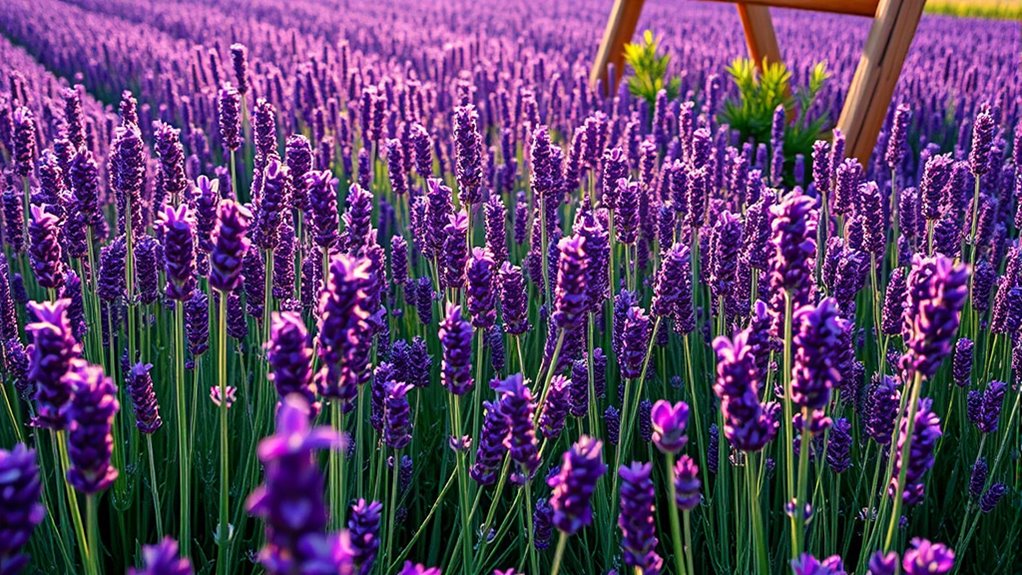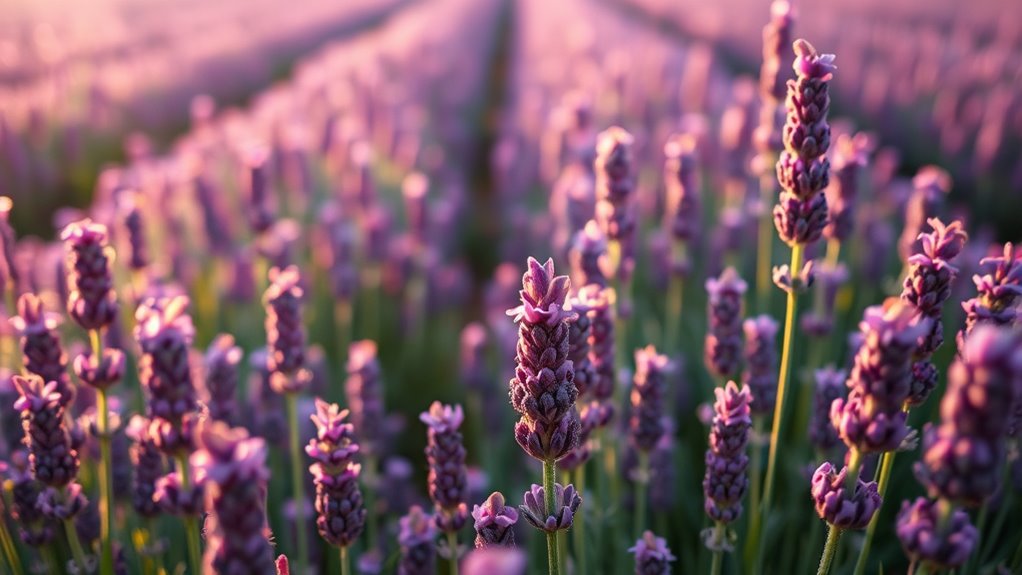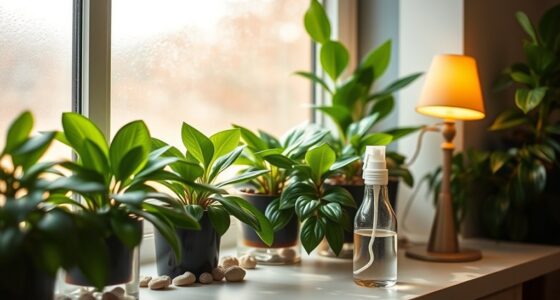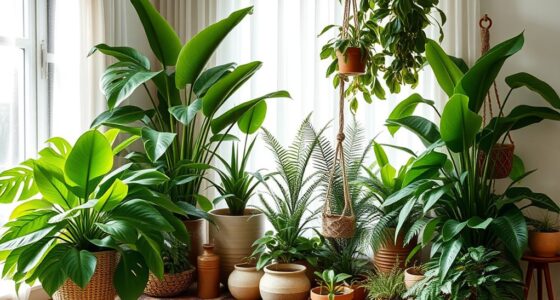To grow and care for lavender, choose the right variety for your climate, like English for cooler areas or Spanish for warmer, drier conditions. Plant with proper spacing to guarantee good airflow and prevent pests. Use well-drained, slightly alkaline soil, and water deeply but infrequently to avoid root rot. Regularly inspect for pests and apply natural remedies if needed. Keep your garden healthy and fragrant by following these tips to open more lavender secrets.
Key Takeaways
- Select lavender varieties suited to your climate, such as English for cooler areas or Spanish for dry, warm conditions.
- Ensure proper spacing and good air circulation to prevent pests and promote healthy growth.
- Use well-drained, slightly alkaline soil and water deeply but infrequently to avoid root rot.
- Maintain garden hygiene by removing debris and inspect regularly for pests like aphids and beetles.
- Mulch to conserve moisture, suppress weeds, and support soil health for vibrant, fragrant lavender plants.

Lavender is a popular and versatile herb that adds beauty and fragrance to any garden, but growing it successfully requires understanding its specific needs. One of the first steps is choosing the right lavender varieties for your climate and space. There are several types, such as English lavender, French lavender, and Spanish lavender, each with unique characteristics. English lavender is the most common and hardy in cooler climates, with a sweet aroma and dense flower spikes. French lavender, with its aromatic gray-green foliage and more delicate flowers, prefers milder weather. Spanish lavender tends to be more drought-tolerant and thrives in warmer, drier conditions. Picking the best variety guarantees your lavender will flourish and gives you the desired scent and appearance.
Once you’ve selected your lavender, focus on pest prevention as part of your care routine. While lavender is generally resistant to pests, it can occasionally attract aphids, spittlebugs, and lavender beetles. To keep these pests at bay, maintain good garden hygiene by removing debris and old foliage that can harbor insects. Regularly inspect your plants, paying close attention to new growth, and if you notice pests, treat them early with natural remedies like neem oil or insecticidal soap. Avoid over-fertilizing, as excessive nutrients can make the plants more attractive to pests and encourage soft, vulnerable growth. Proper spacing also helps, as good air circulation reduces humidity around the plants, making it less appealing for pests and diseases to settle.
Maintain good garden hygiene and proper spacing to prevent pests on lavender plants.
Growing lavender successfully also involves ensuring the right soil and watering practices. Lavender prefers well-drained soil with a slightly alkaline pH, so if your soil is heavy or clay-based, consider amending it with sand or gravel. When watering, do so deeply but infrequently, letting the soil dry out between watering sessions. Overwatering can lead to root rot and other issues that attract pests and disease. Mulching around the plants not only conserves moisture but also prevents weeds that could compete with your lavender for nutrients and water. Additionally, studies show that optimal angles for pinball machines can enhance gameplay performance, which underscores the importance of proper positioning and care for thriving plants.
Incorporate these tips into your gardening routine, and you’ll be rewarded with healthy, fragrant lavender plants. Choosing the right lavender varieties tailored to your climate sets a solid foundation, while proactive pest prevention keeps your plants healthy and thriving. With proper care, your lavender garden will become a fragrant oasis that’s both beautiful and resilient.
Frequently Asked Questions
Can Lavender Survive in Humid Climates?
You might wonder if lavender can survive in humid climates. While lavender prefers drought tolerance and well-drained soil, high humidity can cause problems like root rot. To help it thrive, guarantee your lavender gets excellent soil drainage and avoid overwatering. You can also plant it in a sunny, breezy spot to reduce humidity around the plant. With proper care, your lavender can adapt better even in less-than-ideal conditions.
What Are Natural Ways to Repel Pests From Lavender?
Think of your lavender as a noble guardian, warding off pests naturally. You can use biological control by introducing beneficial insects like ladybugs that prey on pests. Companion planting also acts as a shield, pairing lavender with herbs like rosemary or sage, which repel unwanted visitors. These methods create a harmonious ecosystem, letting your lavender thrive without chemicals, and symbolize a balanced, sustainable approach to pest management.
How Do I Propagate Lavender From Cuttings?
To propagate lavender from cuttings, start with healthy, semi-hardwood stems. Use pruning techniques to trim the cuttings just below a leaf node. Prepare well-draining soil by adding sand or gravel to improve drainage. Dip the cut end in rooting hormone, then plant it in the soil. Keep the soil moist and place the cuttings in a warm, sunny spot. Within a few weeks, roots will develop, and your lavender will grow.
Is Lavender Safe for Pets and Children?
When considering lavender safety, you should know that lavender is generally safe around pets and children. However, pet considerations are important; ingesting large amounts can cause stomach upset or other issues for animals. For children, lavender is usually safe in small amounts, but it’s best to keep it out of reach to prevent any accidental ingestion. Always consult a veterinarian or pediatrician if you’re unsure about lavender’s safety in your home.
How Often Should I Fertilize My Lavender?
Ever wonder when to give your lavender a boost? The key lies in a consistent fertilizer schedule. You should fertilize your lavender once in early spring with a balanced, low-nitrogen fertilizer to boost soil nutrients. Then, avoid overfeeding, as too much can harm the plant. During the growing season, a light feeding every 6-8 weeks helps maintain healthy growth, ensuring your lavender stays vibrant and fragrant all season long.
Conclusion
With a little effort, you’ll be harvesting fragrant lavender in no time, turning your garden into a true Eden. Remember to water wisely, prune generously, and bask in the soothing aroma that fills the air—much like a Victorian lady’s delicate perfume. Soon, you’ll enjoy the calming beauty of lavender, whether in a bouquet or a simple sachet. Keep tending, and your garden will be your own little paradise, a fragrant haven that transports you back in time.









